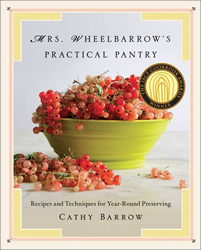
This is a quickie post, while I spend time working on the next one. It’s time to get your kraut fermenting, folks! If Oktoberfest is calling your name. If you like to enjoy wintery stews, sausages, charcroute. And especially if you’re from Baltimore, and Thanksgiving meant sauerkraut on the table, hon, get chopping! And for you non-believers, having a bit of fermented food in your diet can be really beneficial to the digestion – it’s high in antioxidants and vitamin C. Here’s an interesting article.
And it tastes great!
Now is the time, the farmers markets are full of the most beautiful green cabbages. About 1.5# each, they’re the perfect young cabbage for sauerkraut. The best kraut comes from the freshest cabbage, so get your hands on a bright green, tightly formed cabbage and start fermenting right away.
Find a good crock or big glass jar. If I hit the lottery, I’m going to get one of these crocks, but in the meantime, I’ve got mine in a cylindrical vase that a flower arrangement came in! Hint: you can almost always find large glass jars at Marshalls for very reasonable prices.
I learned a great trick for weighting it down from Eugenia Bone’s excellent book Well Preserved. Fill a ziplock bag with a brine solution made up of one quart of water and 1-1/2 Tablespoons of kosher salt. This provides sufficient weight, and if it were to break, it won’t hurt the kraut (just make it watery.) I used to make weird contraptions including old plates and bricks in plastic bags.

So, chop up your sauerkraut. You can use the food processor, a box grater (largest hole) or, do as I do, and quarter and core the cabbage, then slice thinly to make ribbons of cabbage that turn into silky sauerkraut. Rinse the cabbage well and shake the water off using a colander.
Toss the cabbage ribbons with 1 Tbls. of kosher salt for every pound of cabbage. Pack the cabbage into your crock/jar and press down firmly. Top with the ziplock bag filled with brine. Cover with plastic wrap. Put it in a cool spot. Mine sits on the counter, in a place that’s pretty dark and stays cool, because I like to see what’s going on. Here’s a picture from day one.
In about 24 hrs., (second photo) the cabbage will have let off enough juice to cover. If it’s not completely submerged in two days, add some brine (1 quart water + 1.5 Tbls. salt) just to cover. If the cabbage is fresh, you shouldn’t have to do this. Over the next few days/weeks, you’ll see bubbles rising lazily. That’s fermentation!
Over time, the kraut will turn from bright green to yellow and the bubbles will stop. It will take about a month to six weeks for the kraut to ferment. Lift the cover and take a sniff. You’ll know when it’s ready. Pack it in jars. What you do next is up to you.
Some people put the jars through a boiling water bath for 10 minutes to seal them. Others feel this kills the best qualities of fermented food, and just put the jars on the shelf. Others just dip into the jar to help themselves and, when it gets low, just add more cabbage. Giardiniera is an Italian version, adding cauliflower, celery, peppers, carrots, mushrooms and zucchini.
I put the jars on the shelf. They don’t last very long. I’ve already made 12 pints this summer, and gone through seven of them. This batch started with three cabbages (4.5 lbs.) and looks like it will become about 5 pints. I’m going to need more.












Helen
A large glass "biscuit jar" — easy to find at places like Target and Bed, Bath and Beyond — also works well because it has a wide mouth and a nice heavy lid without any metal, which could react to all that acidity (a similar concern when making your own vinegar). And while we're at the farmers' market, pick up an extra head of cabbage to braise in the Alsatian style (sweet and sour with apples, red wine vinegar, cinnamon, bay leaf, etc.) for dinner that night, with a good hearty sausage and some hard cider. Autumn food is wonderful, isn't it?
MrsWheelbarrow
Helen – Oh, yes, we can't forget the wonders of slow braised cabbage. But you seem to have omitted the quintescential ingredient – BACON!
Travis
I’m a member of a CSA here in Austin, TX. Our warm climate means that I’m getting fresh cabbage only now. This afternoon I’m starting my kraut, but have a question about the shelf life. If I just put the kraut in a jar post-fermentation without doing a hot water bath how long will it last? Do I need to worry about it spoiling at some point?
Cathy
I’ve kept kraut in the refrigerator for a month. It usually doesn’t last that long around here! I know there are a lot of resources that will answer your question more directly – try googling “lacto fermentation sauerkraut.”
Audrey in Oregon
I’ve been making my own sauerkraut for years. I’ve read that it’s better to brine in cooler months, because a slow fermentation is better.
Any thought on that?
Cathy
I’m sure that’s true – I tried making sauerkraut last fall when it was still quite warm. After a few days, it went moldy and smelled hideous.
Adrian
If you get fresh cabbages from a farmers market, they will be moist enough to not need rinsing and they will provide all the liquid you need in 30 minutes.